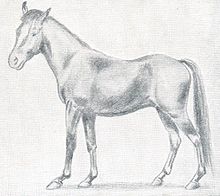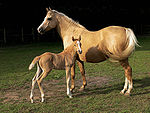- Manipuri Pony
-
Manipuri 
Distinguishing features Medium sized pony, used mainly for polo Alternative names Manipur Country of origin India Horse (Equus ferus caballus) The Manipuri pony is a breed of pony developed in India. It is an old breed and is thought to have developed from crosses between the Mongolian Wild Horse and the Arabian that were subsequently brought to India by invading Tartar tribes. The Manipuri pony was originally bred for polo and military usage, and today is bred mainly for playing polo and racing, although it is also in demand for military transport use.
Contents
Breed Characteristics
Manipuri ponies have a light head with a straight profile, set on a well formed neck, somewhat pronounced withers, a deep chest and sloping shoulders. The croup is sloping, the legs sturdy and the hooves well-proportioned. The breed's overall appearance is elegant, an inheritance from their Arabian ancestors. Manipuri ponies generally stands 11 to 13 hands (44 to 52 inches, 112 to 132 cm) high[1] They are generally bay in color, but are also seen in piebald, gray and chestnut.[2] Because of the short height of the ponies, riders use shortened mallets while playing polo.[3] The Manipuri pony resembles, and is distantly related to, the Burmese Pony and the Indonesian Batak and Sumba ponies.[4]
History
The Manipuri pony is thought to have been derived from ancient stock, as a cross between the Mongolian Wild Horse and the Arabian. They were probably brought to India by invading Tartar tribes, who also brought the equestrian game of polo.[1] The breed has been bred for centuries in the Manipur area of northeast India.[5] The first written mention of the breed dates to a brief mention in 1584 in the Manipur Royal Chronicle. By the early 1600s, the breed is mentioned frequently in Manipur literature. They were often used as cavalry horses, and were ridden by Meitei warriors. Manipuri ponies played a major part in the cavalry commanded by Gharib Newaz, and in 1738 were used during his Sack of Sagaing. His horsemen terrorized upper Burma throughout the early 1700s.[4] There were further infusions of Arabian blood in the 19th century, as British administrators and military officers sought to upgrade the ponies on which they played polo.[6] Between 1859 and 1916, Manipuri ponies were extremely desired by the British for playing polo. The height of polo horses was initially restricted to 13 hands (52 inches, 132 cm) (based on the average height of the Manipuri), and although this restriction was later relaxed to 14 hands (56 inches, 142 cm) and then removed altogether, demand for Manipuris was so high that the area was drained of ponies. At one point during this period, the export of ponies from Manipur was banned to allow the breed time to increase in number to a viable level.[4]
Australian Waler horses were brought to Manipur during World War II for use as pack ponies, and may have contributed to the Manipuri pony.[4] Manipuris were also used to transport British troops into Burma throughout the war.[7] In 1977, the Manipur Horse Riding and Polo Association was established to promote the Manipuri pony breed and the game of polo.[8] In recent years, breed numbers have decreased, and estimates place the breed at somewhere between 2,300[5] and 1,000 in population in the 21st century. Population numbers continue to dwindle in part due to high numbers of ponies being smuggled into Myanmar (Burma), where the breed is in demand, after either having been purchased or stolen from their Indian owners. In 2005, a heritage park was begun by the Manipur Horse Riding and Polo Association with the goal of preventing the extinction of the breed and promoting them to tourists.[7]
Uses
Polo was introduced in to the area of Manipur state as early as the seventh century, and Manipuri ponies were one of the first breeds used in the game.[2] The British learned of the game of polo during the 19th century while watching it played on Manipuri ponies in India. The breed is still used for polo today in India, but other breeds are more popular in Europe and America.[1] They are also used extensively for racing.[5] Manipuri ponies were also in demand as cavalry horses, and men that rode these ponies were thought well-mounted. They continue to be in demand for military uses.[2]
References
- ^ a b c Bongianni, Maurizio (editor) (1988). Simon & Schuster's Guide to Horses and Ponies. New York, NY: Simon & Schuster, Inc.. p. Entry 120. ISBN 0671660683.
- ^ a b c Hendricks, Bonnie (2007). International Encyclopedia of Horse Breeds. University of Oklahoma Press. ISBN 9780806138848.
- ^ Edwards, Elwyn Hartley (1994). The Encyclopedia of the Horse (1st American Edition ed.). New York, NY: Dorling Kindersley. p. 201. ISBN 1564586146.
- ^ a b c d "Manipuri Pony Breed Standard". Indigenous Horse Society of India. http://www.horseindian.com/Manipuri-Pony-Breed-Standard.htm. Retrieved 2011-04-04.
- ^ a b c "Equines in India". National Research Centre On Equines (Indian Council on Agricultural Research). http://nrce.nic.in/eqindia.htm. Retrieved 2008-02-27.
- ^ Edwards, Elwyn Hartley (1994). The Encyclopedia of the Horse (1st American Edition ed.). New York, NY: Dorling Kindersley. p. 197. ISBN 1564586146.
- ^ a b "Park boon for Manipur pony - Polo association to build heritage hub to try and save dying species". The Telegraph. December 29, 2008. http://www.telegraphindia.com/1081229/jsp/northeast/story_10312865.jsp. Retrieved 2011-04-04.
- ^ "A ride through the changes in modern Polo". The Economic Times. December 5, 2010. http://economictimes.indiatimes.com/articleshow/7045675.cms?prtpage=1. Retrieved 2011-03-31.
Equine Equine science and
management
Equestrianism
and sportGlossary of equestrian terms · List of Equestrian Sports · Horse tack · Bit · Bridle · Saddle · Harness · English riding · Western riding · Driving · Horse training · Horse racing · Equestrian at the Summer Olympics (medalists, venues) · Horse show · EquitationEvolution and history Domestication · In warfare · In the Middle Ages · Horses in East Asian warfare · History of the horse in South Asia · Horses in the Napoleonic Wars · Horses in World War I · Horses in World War II · History of the horse in BritainHorse breeds, types
and other EquidaeList of horse breeds · Wild horse · Feral horse · Stock horse · Gaited horse · Draft horse · Warmblood · Sport horse · List of horse breeds in DAD-ISOther EquusHybridsCategory: Equidae Categories:- Horse breeds
- Horse breeds originating in India
- Indian culture
Wikimedia Foundation. 2010.
